Integrated development: Efforts to improve social indicators making an impact
In the last two decades, Morocco has accelerated broad-based efforts to expand access to social services and encourage inclusive growth. Most notably, a spate of reforms adopted in the early 2000s helped to expand women’s rights and increase recognition of Berber cultures and languages. The impact has been noticeable and on the whole, Morocco has strong socio-economic indicators compared to other countries in the region. Morocco’s gross national income per capita falls behind that of regional leaders Algeria and Tunisia, but grew annually by 2.5-3.5% over the last five years to reach $2445.2 in 2012 (constant 2005 prices). Unemployment levels, which reached 9% overall and 18.6% for youth in 2012, are lower than in other Maghreb countries. Over 43% of the Moroccan labour force has at least a secondary education, and 11.6% has a tertiary education, putting Morocco just behind the regional leader, Algeria.
HUMAN DEVELOPMENT: That is not to say that everything is perfect, however, and work remains to be done to ensure equal access throughout the country to basic social services. As part of this, the government launched the National Initiative for Human Development (Initiative Nationale pour le Développement Humain, INDH) in May 2005 to address poverty and social inequality. The INDH outlines a variety of projects meant to improve health and education infrastructure, encourage revenue-generating activities, widen access to social services, expand cultural and sports infrastructure, provide professional training and strengthen local governance on social issues. The initiative aimed to facilitate Dh10bn (€888m) in public and private investment in the first five years, and officials estimate that 59% of these funds had been disbursed by year-end 2010.
Morocco’s education indicators are generally strong; the net primary enrolment rate rose from 85% in 2003 to 98.7% in 2013, evenly divided between boys and girls. Adult literacy is also on the rise, but at 67.1% in 2011, it leaves room for improvement. The INDH planned an investment of nearly Dh2bn (€177m) in education over 2006-10. Roughly 3200 projects were realised, including efforts to expand infrastructure, better equip schools and libraries, and offer more preschool and daycare programmes. Another Dh1.1bn (€97m) was slated for the health sector in 2006-10.
Roughly 1340 projects were completed under this segment, including the construction of health centres and hospitals, and the acquisition of equipment. Life expectancy has risen two years in the past decade to 70.6 in 2012 (72.5 for women, 68.9 for men), but Morocco is faced with a non-communicable disease burden and disparate quality of health services in rural and at-risk areas. The initiative also seeks to raise women’s participation in governance, noting that seats held by women in human development committees increased to only 16% in 2010, from 9% in 2006.
SUBSIDY REFORM: Morocco administers a subsidy regime for food and fuel products which aims to ensure that key products remain accessible to low-income populations. Subsidies weigh heavily on public expenditure, amounting to Dh53bn (€4.7bn) in 2012, or 6.5% of GDP. However, according to a January assessment by the International Monetary Fund (IMF), just 9% of all subsidy spending benefits the poorest quintile of the population, but 75% spending on diesel and fuel subsidies actually benefits the richest quintile of the population (see Economy chapter).
To correct this imbalance, the government has adopted a reform programme that aims to replace blanket subsidies with measures that directly benefit low-income populations, to reduce costs without unduly hurting the most vulnerable. The state eliminated subsidies on petrol and industrial fuel not used for electricity in January 2014, and diesel subsidies will be reduced from Dh2.15 (€0.19) per litre to Dh0.80 (€0.07) by October. The government also introduced measures to limit fare hikes for public transportation, expand support for children and provide medical care, improving key services for lower-income earners.
You have reached the limit of premium articles you can view for free.
Choose from the options below to purchase print or digital editions of our Reports. You can also purchase a website subscription giving you unlimited access to all of our Reports online for 12 months.
If you have already purchased this Report or have a website subscription, please login to continue.

